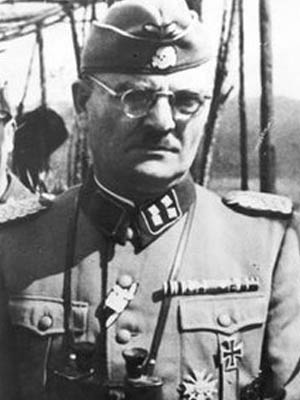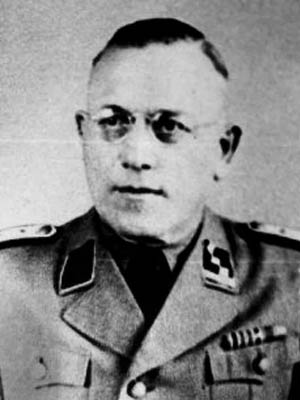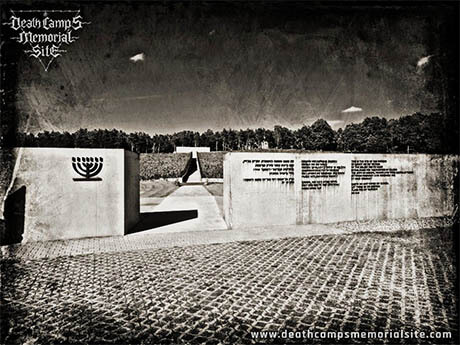Belzec - German extermination camp
Period of operation: 1942 - 1943
Place / City: Bełżec
Estimated number of victims: 450 000 *
* - 434,000 casualties are a certain number, based on the decrypted telegram sent by Hermann Höfle. The maximum number of 600,000 people is mentioned in Chris Webb's book "The Belzec Death Camp: History, Biographies, Remembrance". As part of Action 1005, the camp was completely obliterated, and virtually all documents were destroyed. Only two clearly confirmed cases are known when prisoners of the Bełżec camp managed to escape from the camp and survive the war. It is generally accepted that the number of victims is 450,000
Commandants of the Belzec extermination camp
Christian Wirth

Gottlieb Hering

SS SONDERKOMMANDO BEŁŻEC was the first German Nazi extermination camp established in the General Government. The construction of the camp began on October 31, 1941, and the last prisoners, after covering up the traces of the crime, left the camp on June 26, 1943. According to various estimates and calculations, it is assumed that the number of victims of the camp was approximately 450,000. The mass extermination process itself lasted from March 17 to mid-December 1942. From December 1942 to June 1943, the camp was completely obliterated as part of Special Action 1005, and virtually all documents were destroyed. Only two unambiguously confirmed cases are known where prisoners of the Bełżec camp managed to escape and survive the war.
As in Treblinka, before the creation of the extermination camp, a forced labor camp with the functions of a transit and penal camp was established there. The camp functioned from the spring of 1940, and the prisoners' task was to build, among others, fortifications to secure the border with the Soviet Union. The camp commandant was SS-Sturmbannführer Hermann Dolp. About 11,000 prisoners were imprisoned in the Bełżec camps and the sub-camps in Leipzig, Płazów, Cieszanów and Dzików Stary: Poles, Roma, and Jews.
The decision to build an extermination camp was most likely made on October 13, 1942 in the Wolf's Lair. The meeting was attended by: Heinrch Himmler - head of the SS, Odilo Globocnik - SS and Police commander in the Lublin District of the General Government, and Friedrich Kruger - secretary of state for security and plenipotentiary of strengthening Germanness in the General Government.
Three secret centers of immediate extermination were established in the General Government. The first was the camp in Bełżec, which was a kind of "testing ground" in the "final solution of the Jewish question" in this area. The experience gained here was later used in Sobibór or Treblinka. The victims were murdered with carbon monoxide in stationary gas chambers, and the operation was codenamed "Aktion Reinhardt".
The location of the first camp was the town of Bełżec, situated on the border of the districts of the General Government: Lublin, Kraków, and, from August 1941, Galician. A railway line connecting Warsaw with Lviv ran through Bełżec, and a junction station in Rawa Ruska, through which the railway line from Kraków ran, was located nearby. The camp itself occupied an area of about 7 hectares and was located several hundred meters southeast of the train station. The whole area of the camp was fenced with a high fence consisting of barbed wire and branches, which effectively masked what was happening in the camp.
On October 30, 1941, Richard Thomalla from the SS construction board, Gottfierd Schwarz and Józef Oberhausen arrived in Bełżec and began to organize the construction of the camp infrastructure. The first works were carried out by Polish forced laborers, who, under the supervision of the SS, erected camp buildings, and then a group of Jewish workers sent to Bełżec. The camp itself was divided into two zones, i.e. camp I (administrative and economic part) and camp II (the place of extermination).
On December 22, the construction of the camp was taken over by Christian Wirth, who was also officially the first commandant of the camp in Bełżec. The construction works lasted until February 1942, and after their completion a group of about 120 workers - Jews from Lubycza Królewska - were killed in the gas chamber.
On March 17, the first mass transports of Jews came from the ghettos in Lublin and from round-ups organized a few days earlier in Lviv as part of the so-called "March action". In the weeks that followed, mass transports, incl. from Zamość, Izbica, Trawniki, Kołomyja, Kraśnik and the surrounding towns, reached Bełżec.
From April 14 to May 22, there was a break in the mass deportations. Christian Wirth left for Berlin, where he most likely received orders to accelerate the extermination. After Wirth's return to the camp, mass transports and mass extermination resumed. On June 2, the first group of 2,000 Jews from the Krakow ghetto arrived in Bełżec. In the following days, transports from Tarnów and Dąbrowa Tarnowska started arriving, including many women and children considered unfit for work by the Germans. In the period from June 18 to July 9, there was a second break in the mass extermination. This was due to the construction of a new, more efficient gas chamber, which could kill about 4,000 victims at a time. Lorenz Hackenholt, also known as the "Master of Gas", was responsible for their construction (read here: Lorenz Hackenholt - "Master of Gas").
In July 1942, another mass deportation began, which lasted until December 1942. On August 1, Gottlieb Hering replaced Christian Wirth as the commandant, who was appointed the Inspector of Operation Reinhardt. From that moment on, Wirth supervised the functioning of the camps in Bełżec, Treblinka and Sobibór. The last mass transports to the camp arrived between December 7 and 11, 1942. According to various data, it is estimated that approximately 180 mass transports arrived from March 17 to December 11.
Most probably, due to the lack of space in the mass graves, the extermination in Bełżec was stopped, and the mass transports were directed to Sobibór, Treblinka and Majdanek. A group of prisoners who had so far worked in commandos within the camp began to cover up the traces of mass extermination. The last group of 300 prisoners was deported on June 26, 1943 to the death camp in Sobibór. Upon their arrival, they started a revolt on the camp ramp, and as a result, they were shot.
The camp staff, as in other Reinhardt operation centers, consisted of about 15-25 SS men, as well as a group of about 100 watchmen from the east (mainly from the Ukraine), who had previously undergone adequate training in the Trawniki camp (read here: SS Wachmannschaften, torturers from the East). As of today, we have information that at least 35 Germans and 2 Austrians (also members of the SS) passed through the camp during its operation. Some of them participated in the previously mentioned T4 action. The entire camp staff, as well as Operation Reinhardt inspectorate, were subordinate to Odilo Globocnik. He coordinated operation "Reinhardt", during which approximately 1.8 million Jews from the General Government and the Białystok District were murdered in death camps and in mass executions. (read here: Odilo Globocnik - death administrator.)
From March 1942, the camp became a mass extermination site for the Jewish population. At least 434,000 people were sent there, mainly from the General Government area. Among the victims were also citizens of the Czech Republic, Slovakia, Hungary, Austria and Germany. Transports with the Jewish population were brought in cattle cars, where on average about 100 people were crammed into one car. The extreme conditions of transport - overcrowding, heat, lack of water and food - caused the death of many people on the way to Bełżec. Upon arrival, the newcomers were deprived of their property, and then immediately directed to camp two, where, after cutting their hair, they were ordered to undress. Then, people were directed to a gas chamber powered by exhaust gases of a diesel engine. The bodies were buried in mass graves in the second camp. Later, the bodies were placed in pits, poured over with gasoline and set on fire.
A group of prisoners was selected from the transports to work in various commandos in the camp (kitchen, forestry commando, laundries, etc.), as well as to work in the death zone. The tasks of the latter included, inter alia, digging graves, emptying gas chambers, or transporting bodies to mass graves. There was also a commando of dentists who pulled out golden teeth from gassed victims.
At the time of the largest deportations, there were about 500 prisoners sent to work in the camp. There was also a gallows in Camp II, where prisoners were publicly hanged for breaking camp regulations (e.g. misappropriation of property), which was to be a warning to other members of the Sonderkommando. From time to time, there was also an internal selection, during which weakened (both physically and mentally) prisoners from the commandos were shot, and the shortcomings were replaced by selected prisoners from new transports.
Of the first three extermination camps established as part of Operation Reinhardt, Bełżec was the only one in which there was no armed rebellion or uprising. Very few people made an attempt to escape.
Chaotic but very deliberate action, disinformation, brute force and tremendous speed of action were key elements of the extermination mechanism. Their combination was intended to lead to a situation in which prisoners sentenced to death would not be aware of their awaiting fate until the last moment, and at the same time would be deprived of any possibility of real resistance.
Only two unambiguously confirmed cases are known where prisoners of the Bełżec camp managed to escape from the camp and survive the war. These fugitives were:
Rudolf Reder – he escaped, taking advantage of the guard's inattention. Until the end of the war, he hid with the help of his Polish friends. After the war, he emigrated from Poland.
Chaim Hirszman - in June 1943, he escaped from the train in which the last group of prisoners was transported to Sobibór, to their death. In March 1946, he was shot in Lublin by teenage Poles, members of an anti-communist youth organization.
There are reports of other people who escaped from Bełżec but did not live to see the end of the war. Their number is estimated at 10 to 13 people.
Bełżec was the first "Reinhardt" operation camp to be liquidated. Its crew members were transferred to the extermination camp in Sobibór or to various labor camps in the Lublin district. Commandant Gottlieb Hering was transferred to the position of the commandant of the labor camp in Poniatowa, and his deputy, Gottfried Schwarz, took the position of the commandant of the labor camp in Dorohuha. Christian Wirth was transferred to Trieste in 1943. There, he headed a special unit called SS-Einsatzkommando R (Einsatz R), composed mostly of veterans of Operation Reinhardt, including Józef Oberhauser and Franz Stangl. Its task was to liquidate the local Jews and fight the Yugoslav and Italian partisans. On May 6, 1944, he was killed by Yugoslav partisans in a skirmish at Erpelle near Trieste.
Due to the lack of accounts of witnesses and reports of camp torturers, we are not able to clearly indicate the number of people murdered in Bełżec. What we can be sure of, basing on the decoded telegram sent by Hermann Höfle, is that the number of deaths is 434,000. In Chris Webb's book, “The Belzec Death Camp: History, Biographies, Remembrance”, a maximum of 600,000 people is mentioned. Due to the divergent information, the number of victims is still difficult to determine. It is generally accepted that the number of victims is 450,000. However, as I mentioned, these are only statistical data, empty numbers behind which there are countless innocent victims of Operation Reinhardt.
Museum:
Memorial Site in Bełżec was founded in 2004 as a branch of the State Museum at Majdanek. One of its main responsibilities is documenting and commemorating the victims of the German death camp in Bełżec. The museum’s activity concentrates on historical education and providing guide services: www.belzec.eu/en/
Related Articles
- Sculpture of railway tracks - Belzec
- Treblinka, Bełżec, Sobibór: Gas chambers and their commemoration
- Gas chambers in Germans death camps
- Bełżec - silent death sentence
- Lorenz Hackenholt - "Gas Master"
- SS Wachmannschaften, torturers from the East - part 1
- SS Wachmannschaften, torturers from the East - part 2
- SS Wachmannschaften, torturers from the East - part 3
- Odilo Globocnik - Death Manager
- Franz Stangl - Commander Of Death Camps
- Exhaust gas chambers
Timeline:
1941-10-13 ▪ the decision to build the extermination camp in Bełżec was made at the meeting of Heinrich Himmler with Friedrich Krüger and Odilo Globocnik.
1941-10-30 ▪ SS-Hauptsturmführer Richard Thomalla from the SS Central Construction Board in Lublin and SS non-commissioned officers Gottfried Schwarz, Josef Oberhauser and Johann Niemann came to Bełżec and began organizing the construction of the camp.
1941-12-22 ▪ SS-Obersturmführer Christian Wirth came to Bełżec and took over command of the construction and organization of the camp.
1942-02-XX ▪ around 120 Jews from Lubycza Królewska, who were then murdered in gas chambers, completed the construction of the camp in Bełżec.
1942-03-17 ▪ mass deportations from the ghettos in Lublin and Lviv to the death camp in Bełżec began.
1942-06-01 ▪ at the beginning of June, deportations of Jews from the Kraków district to Bełżec began.
1942-06-18 ▪ in the Bełżec camp, the Germans built new concrete gas chambers.
1942-08-01 ▪ Gottlieb Hering replaces Christian Wirth in Bełżec. Wirth is appointed camp inspector of "Operation Reinhardt".
1942-08-17 ▪ Rudolf Reder, who survived the war and testified afterwards, is deported to Bełżec.
1942-11-01 ▪ Chaim Hirszman, who was one of the few who survived his stay in the extermination camp, was deported to Bełżec.
1942-12-11 ▪ the last deportation to the Bełżec camp. 2.5 thousand people are deported from Rawa Ruska.
1943-06-26 ▪ a group of the last Jewish prisoners who took part in blurring the traces of the Bełżec camp were deported to Sobibór, where they were murdered.
Bełzec camp - photo gallery
Virtual Tour:
